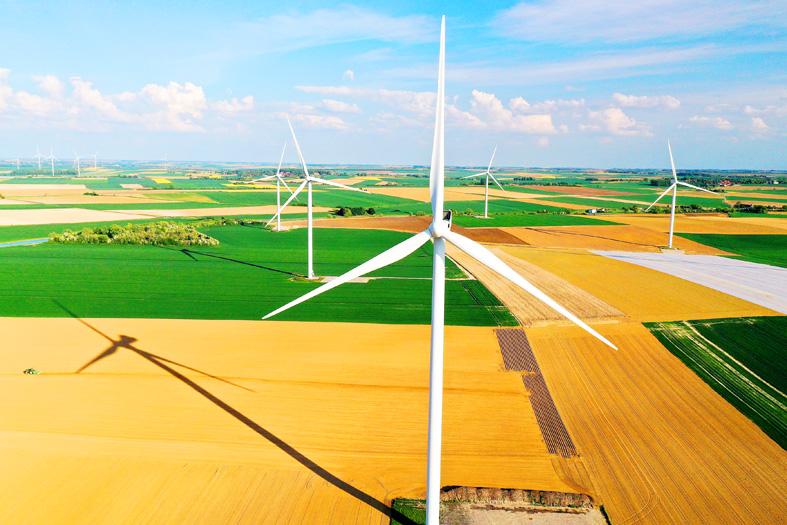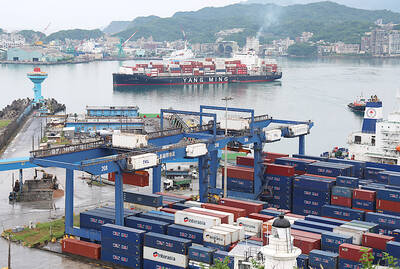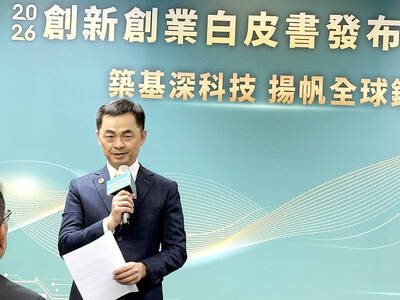Wind and solar power are the cheapest form of new electricity in most of the world today, according to an analysis by BloombergNEF (BNEF).
The research organization predicts a tipping point in five years when it would be more expensive to operate an existing coal or natural gas power plant than to build new solar or wind farms.
The findings add to research showing why renewables are spreading in most power markets.

Photo: Reuters
Last week, the International Energy Agency said that solar is starting to take over from coal as the cheapest form of electricity.
However, there is an economic limit to the spread of those sources of clean energy, BNEF chief economist Seb Henbest said at the research group’s annual conference in London on Monday last week.
There would come a point in every country that saturation is reached because the technology no longer reduces generation costs compared with running the existing thermal generation fleet.
Those constraints suggest renewables would gain no more than 70 to 80 percent of the market for electricity generation, depending on local conditions. Even in Europe, which has some of the toughest policies encouraging renewables and discouraging fossil fuels, wind and solar are unlikely to surpass 80 percent of supply.
That level of penetration “is far off in pretty much every market we look at,” Henbest said in a presentation outlining the first findings of BNEF’s New Energy Outlook, which is to be published in full later this month.
“We’re not going to reach these limits anytime soon and we can of course push past these limits,” he said.
The shift toward renewables is likely to reshape a number of industries, especially the shipping business. A third of the cargo tonne kilometers hauled by shippers comes from moving fossil fuels around the globe, and 70 percent of that portion is oil, BNEF said.
As renewables take market share from oil, gas and coal, the shipping companies that deliver those fuels and keep it fed with machinery and pipelines would also suffer.
“There’s quite possibly a rebasing of shipping demand and rail demand, that might mean less energy consumption and lower emissions,” Henbest said.
Using electricity to heat homes and power vehicles could save energy and emissions, the report showed.
Driving an electric vehicle uses as much as three times less energy than a conventional combustion engine, BNEF said.
Switching to heat pumps instead of traditional gas boilers would make warming buildings far more efficient by several multiples, according to the BNEF findings.
It estimates that melting down old steel and reforming it is five times more energy efficient than making the material from scratch.
In power generation, BNEF estimates that coal is also one of the most inefficient ways to make electricity since 65 percent of energy is lost in the process of burning the fuel. The energy lost in generating electricity from wind is almost zero.
The result is that if renewables take a bigger share of the energy mix, the world will need less energy to generate the same amount of electricity, BNEF said.
“Overall, what this means is that we can get better end use energy efficiency from using electrical processes and technology downstream,” Henbest said. “If we use renewables to generate electricity, we get gains midstream as well. Overall this translates into maybe say two to three times less primary energy supply.”

CHIP RACE: Three years of overbroad export controls drove foreign competitors to pursue their own AI chips, and ‘cost US taxpayers billions of dollars,’ Nvidia said China has figured out the US strategy for allowing it to buy Nvidia Corp’s H200s and is rejecting the artificial intelligence (AI) chip in favor of domestically developed semiconductors, White House AI adviser David Sacks said, citing news reports. US President Donald Trump on Monday said that he would allow shipments of Nvidia’s H200 chips to China, part of an administration effort backed by Sacks to challenge Chinese tech champions such as Huawei Technologies Co (華為) by bringing US competition to their home market. On Friday, Sacks signaled that he was uncertain about whether that approach would work. “They’re rejecting our chips,” Sacks

Taiwan’s exports soared 56 percent year-on-year to an all-time high of US$64.05 billion last month, propelled by surging global demand for artificial intelligence (AI), high-performance computing and cloud service infrastructure, the Ministry of Finance said yesterday. Department of Statistics Director-General Beatrice Tsai (蔡美娜) called the figure an unexpected upside surprise, citing a wave of technology orders from overseas customers alongside the usual year-end shopping season for technology products. Growth is likely to remain strong this month, she said, projecting a 40 percent to 45 percent expansion on an annual basis. The outperformance could prompt the Directorate-General of Budget, Accounting and

NATIONAL SECURITY: Intel’s testing of ACM tools despite US government control ‘highlights egregious gaps in US technology protection policies,’ a former official said Chipmaker Intel Corp has tested chipmaking tools this year from a toolmaker with deep roots in China and two overseas units that were targeted by US sanctions, according to two sources with direct knowledge of the matter. Intel, which fended off calls for its CEO’s resignation from US President Donald Trump in August over his alleged ties to China, got the tools from ACM Research Inc, a Fremont, California-based producer of chipmaking equipment. Two of ACM’s units, based in Shanghai and South Korea, were among a number of firms barred last year from receiving US technology over claims they have

BARRIERS: Gudeng’s chairman said it was unlikely that the US could replicate Taiwan’s science parks in Arizona, given its strict immigration policies and cultural differences Gudeng Precision Industrial Co (家登), which supplies wafer pods to the world’s major semiconductor firms, yesterday said it is in no rush to set up production in the US due to high costs. The company supplies its customers through a warehouse in Arizona jointly operated by TSS Holdings Ltd (德鑫控股), a joint holding of Gudeng and 17 Taiwanese firms in the semiconductor supply chain, including specialty plastic compounds producer Nytex Composites Co (耐特) and automated material handling system supplier Symtek Automation Asia Co (迅得). While the company has long been exploring the feasibility of setting up production in the US to address